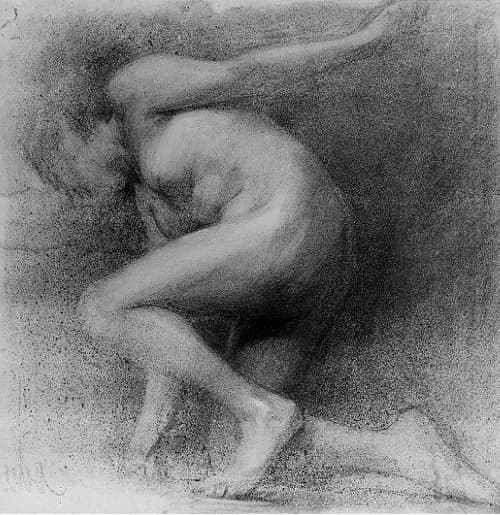Copyright © 1986, 2006 Libreria Editrice Vaticana, 00120 Citta del Vaticano, for the original texts of John Paul II and the then-Cardinal Karol Wojtyła. The texts may be found on the Vatican website: www.vatican.va. Edition copyright © 2006, 1997, Daughters of St. Paul.
Behind the need for shame, that is, for the intimacy of one’s own body (about which the biblical sources inform us with such precision in Genesis 3), a deeper norm lies hidden: that of the gift oriented toward the very depths of the personal subject or toward the other person, especially in the man-woman relation according to the perennial order of reciprocal self-giving. Thus, in the processes of human culture understood in the broad sense, we observe—even in the state of man’s hereditary sinfulness—a rather explicit continuity of the spousal meaning of the body in its masculinity and femininity. Original shame, known already from the first chapters of the Bible, is a permanent element of culture and morality. It belongs to the very origins of the ethos of the human body.
A person of developed sensibility crosses the limit of that shame only with difficulty and inner resistance. This is clear even in situations that otherwise justify the necessity of undressing the body, for example, in the case of medical examinations or operations.
In a group by themselves, one should also recall other circumstances, e.g., those of concentration camps or places of extermination where the violation of the bodily shame is a method used consciously to destroy personal sensibility and the sense of human dignity. Everywhere—though in different ways—the same line of order is reconfirmed. Following his personal sensibility, man does not want to become an object for others through his own anonymous nakedness, nor does he want the other to become an object for him in a similar way. It is evident that he “does not want to” to the degree in which he lets himself be guided by the sense of the dignity of the human body. There are, in fact, various reasons that can induce, incite, and even press man to act contrary to what the dignity of the human body, connected with personal sensibility, demands. One cannot forget that the fundamental inner “situation” or “historical” man is the state of the threefold concupiscence (see 1 Jn 2:16). This state—and in particular the concupiscence of the flesh—makes itself felt in various ways, in the inner impulses of the human heart as well as in the whole climate of relationships between human beings, and in social morality.
We cannot forget at this point, not even when we consider the issue of the wide sphere of art, above all when it has the character of a visual image or show, and likewise when one is dealing with “mass” culture, which is so significant in our times because it is connected with the broadcasting technology of audiovisual communication. The question arises when and in what case this sphere of man’s activity—from the point of view of the ethos of the body—should be accused of “pornovision” just as some writing has been and is being accused of “pornography” (that second term is older). The one as well as the other happens when one oversteps the limit of shame or of personal sensibility with regard to what is connected with the human body, with its nakedness, when in a work of art or by audiovisual media one violates the body’s right to intimacy in its masculinity and femininity and—in the final analysis—when one violates that deep order of the gift and of reciprocal self-giving, which is inscribed in femininity and masculinity across the whole structure of being human. This deep inscription—or rather incision—is decisive for the spousal meaning of the human body, that is, for the fundamental call it receives, that of forming the “communion of persons” and of participating in it.
…
It is not possible to agree…with the representatives of so-called naturalism who appeal to the right to “everything that is human” in works of art and in the products of artistic reproduction, and who claim that in this way they act in the name of the realistic truth about man. It is precisely this truth about man—the whole truth about man—that requires us to consider the sense of the intimacy of the body and the consistency of the gift connected with the masculinity and femininity of the body itself, which reflects the mystery of man proper to the inner structure of the person. We must consider this truth about man also in the artistic order, if we want to speak of a full realism.
One notices here that the order proper to the “communion of persons” agrees profoundly with the vast and differentiated area of “communication.” As we said already in our earlier analyses (where we turned to Genesis 2:25 [see TOB 13‒19]), the human in its nakedness—understood as a manifestation of the person and as the person’s gift or sign of trust in, and of giving to, another person, who is aware of the gift, who has chosen and decided to respond to it in an equally personal way—becomes the source of a particular interpersonal “communication.” As we said already, this is a particular communication in humanity itself. This interpersonal communication penetrates deeply into the system of communion (communion personarum) and at the same time grows from it and develops correctly in its context. Precisely because of the great value of the body in this system of interpersonal “communion,” making the body in its nakedness—which expresses precisely “the element” of the gift—the object or subject of a work of art or an audiovisual reproduction is a problem that is by nature not aesthetic, but also ethical. In fact, that “element of the gift” is, so to speak, suspended in the dimension of an unknown reception and of an unforeseen response, and thereby it is in some way “threatened” in the intentional order in the sense that it can become an anonymous object of “appropriation,” an object of abuse. This is why the integral truth about man constitutes in this matter the basis of the norm according to which the good or evil of determinate actions of behavior, of morality, and situations is formed. Precisely because of his body and his sex (femininity/masculinity), the truth about man, the truth about what is particularly personal and interior in him, creates precise limits that one must not overstep.
These limits must be recognized and observed by the artist who makes the human body the model or subject of a work of art or audiovisual reproduction. Neither he nor others who carry responsibility in this field have the right to demand, propose, or allow other human beings whom they invite, exhort, or admit to seeing and looking at the image to violate these limits together with them or because of them. What in itself constitutes the content and deep personal value of the order of gift and of the mutual self-giving of the person in the image is, as a subject, uprooted from its own authentic substratum in order to become an object and, what is more, in some way an anonymous object by means of “social communication.”
The whole problem of “pornovision” and of “pornography,” as it appears on the basis of what was said above, is not the effect of a puritanical mentality or of a narrow moralism, nor is it the product of a way of thinking burdened by Manichaeism. What is at issue is rather an extremely important and fundamental sphere of values to which man cannot remain indifferent because of the dignity of humanity, because of the personal character and eloquence of the human body. Through works of art and the activity of audiovisual media, this whole content and these values can be formed and deepened, but the can also be deformed and destroyed “in man’s heart.” We can see that we find ourselves continually within the orbit of the words Christ spoke in the Sermon on the Mount.
John Paul II served as Pope from 1978 to 2005. He was canonized in 2014.
Keep reading! Click here to read our next article, Burning the Body.
John Paul II served as Pope from 1978 to 2005. He was canonized in 2014.



